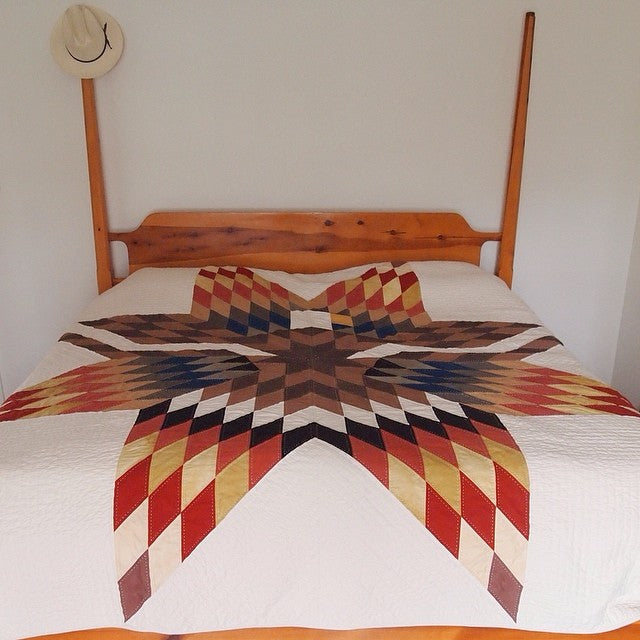
Maker, Maura Ambrose of Folk Fibers, has transformed hand quilting into a brand of her own that has caught the eye of Levis, sending her on train tours and putting her work into their stores. Last year she won the Martha Stewart American Made award for her deep passion in handmade. John Mayer asked her to design the cover for his single, XO, which was such a unique take on any album cover. And the biggest mountain of them all, this year she's began the story of motherhood. Maura and her husband, Chapman, are able to bring a timeless hobby into the modern day pixelated lives of apps and web culture, which is a craft all unto itself. She hand dyes all her fabric, taking us picture by picture through those simple charms, walking us further until we've all reached the end of the quilt's story. As an avid Instagram follower of hers, I get to witness pieces of her process, put so visually well that I feel as though I know the quilt's insides and out. She takes her photos with such care, that it brings life to where you can almost smell the onions skins and pomegranates soaking. Nestled on her 10 acre farm between two cow fields outside of Austin, we talked about this next season in Folk Fibers.
How old is your baby girl, Ada?
"She's eight months, started crawling a few weeks ago and it's going really fast now. It's been a roller coaster of emotions. I love it, but then I miss having unlimited time to be creative. I still get to create, it's just so much harder to find the time. It will come back, as she grows. I love your products! Your Baby Balm is the best and I find I'm using it all the time."
Are there any bunnies in the room with you right now? How have you found the blend with having baby and bunny together?
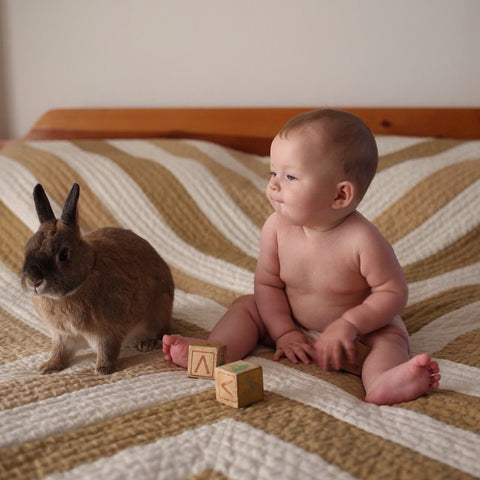 "It's really nice! Right now they're tucked away in the bedroom. The baby's starting to teeth and that makes for times of irritability, but having the rabbits hop around, popping out of nowhere and exploring, is a perfect distraction. Ada gets such a kick out of these magical rabbits hopping next to her. It's fun to watch! I've always wanted to keep the rabbits in the house. They're nice to have and they're a lot like cats. They stay tucked away and sleep for a long time, then come out to see what's going on."
"It's really nice! Right now they're tucked away in the bedroom. The baby's starting to teeth and that makes for times of irritability, but having the rabbits hop around, popping out of nowhere and exploring, is a perfect distraction. Ada gets such a kick out of these magical rabbits hopping next to her. It's fun to watch! I've always wanted to keep the rabbits in the house. They're nice to have and they're a lot like cats. They stay tucked away and sleep for a long time, then come out to see what's going on."
When you first started dying fabrics, what was your very first batch?
"It was in a class at college by Doris Louie about natural dying. We ordered most of our dyes, but there was a local harvest of black walnuts that year, so we had some connection with collecting from the forest. We did a lot of dyes that year, cochineal and logwood. We did everything but indigo, I remember we missed indigo that year. Indigo is more elaborate than the others. If you need to do indigo in a day, you can force the oxidation and reduction process with chemicals. But those chemicals weren't allowed in the fiber studio, so it hindered us from doing indigo. What would be awesome is if they had a professor doing indigo, and a class could come in each day and observe. Because it does take weeks for it to reduce organically. I use madder, soda ash, and wheat bran, which make it reduce and oxidize. You have to look at it everyday, stir it everyday and in a week it's ready, or sometimes give it another day or two. It's not very conducive to a class, similar like making kombucha or yeast."



Your classes taught you how to dye but it seems you've gone a lot deeper and pulled so much more out of it than what they anticipated?
"College gives you a taste for what you might want to get into. I was just looking at the woolery website last night thinking I might want to get into making rugs. I'd learn to card wool, then spin it... but you know what, I did all that at college and you have to pick a focus. I'm going to stick with quilting and natural dyes. It was like being a kid in that candy shop in college. We did everything. We did screen printing, we were weaving, we carded our wool and spun it, we did ink-blot painting. Getting the experience of dying fabrics with all dyes is what helped me fall in love with natural dyes. It takes some time, but for me that's good. I like to walk away and coming back to it. You kinda figure it out... like a baby and then all of a sudden, it's part of your life."
In your creative process of natural dyes, what kind of walls do you hit along the way and how have you found ways to get past those moments?
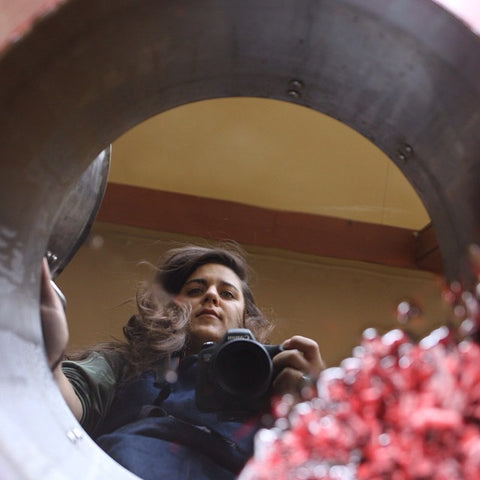 "I was feeling really groovy with all the dyes until the baby. On a nap time I'd get a vat going, put the fabric in it and check on it the next day. That's when my mistakes were happening, when I wasn't doting over it, watching it, and babysitting the dye vats. The mistakes that came were just uneven results, air bubbles that would get into the fabric because they would rise to the top of the dye vat and I wasn't there to tamper it down. It's made for undesired results, unexpected results would be like hitting a wall. I feel like I've had to relearn my process now that I have a new ball to juggle. But with the work that I do, a lot of that fabric can be cut into patchwork, so I can cut around the areas that I don't love. Sometime even the best little exciting pops of color in a quilt are an air bubble's change in color. It's a forgiving art, which is why I like dying and quilting together."
"I was feeling really groovy with all the dyes until the baby. On a nap time I'd get a vat going, put the fabric in it and check on it the next day. That's when my mistakes were happening, when I wasn't doting over it, watching it, and babysitting the dye vats. The mistakes that came were just uneven results, air bubbles that would get into the fabric because they would rise to the top of the dye vat and I wasn't there to tamper it down. It's made for undesired results, unexpected results would be like hitting a wall. I feel like I've had to relearn my process now that I have a new ball to juggle. But with the work that I do, a lot of that fabric can be cut into patchwork, so I can cut around the areas that I don't love. Sometime even the best little exciting pops of color in a quilt are an air bubble's change in color. It's a forgiving art, which is why I like dying and quilting together."
I heard you talk in another interview about having limited resources and it makes me wonder, was there times in your life when you had limited resources or do you keep limited resources now intentionally?
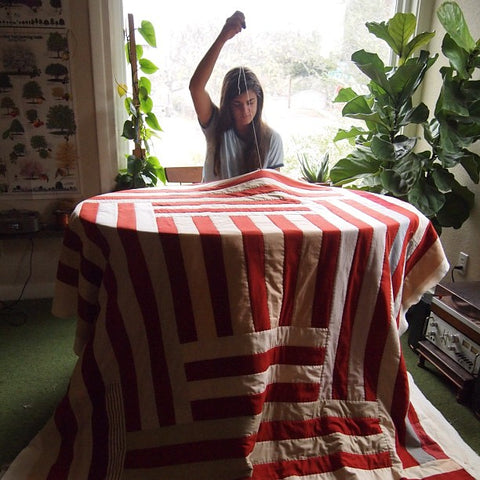 "The first thing that comes to mind when you say that is my fabric shelf, I call my dye library that I pull from to make quilts. I get really overwhelmed and frustrated when shopping at a fabric store. It's really common for quilters to have hordes of fabric. I have some boxes in a closet that are vintage flower sacks and things I'm not using on a regular basis. They're special and I want to afford those things. I don't shop and collect fabric, where I limit my pallet is to what I'm dying or what I dyed. It keeps me focused. When creating a quilt, I'll see on my shelf what I have dyed and then maybe dying a new color specifically for the quilt. It's limited to what I can dye in the dye pot. But at the same time, what I can dye in the dye pot is unlimited because there's so many varieties of color."
"The first thing that comes to mind when you say that is my fabric shelf, I call my dye library that I pull from to make quilts. I get really overwhelmed and frustrated when shopping at a fabric store. It's really common for quilters to have hordes of fabric. I have some boxes in a closet that are vintage flower sacks and things I'm not using on a regular basis. They're special and I want to afford those things. I don't shop and collect fabric, where I limit my pallet is to what I'm dying or what I dyed. It keeps me focused. When creating a quilt, I'll see on my shelf what I have dyed and then maybe dying a new color specifically for the quilt. It's limited to what I can dye in the dye pot. But at the same time, what I can dye in the dye pot is unlimited because there's so many varieties of color."
How do you think your next season with Folk Fiber's is going to play out with being a mom now? How's that changed your vision for Folk Fiber's?
 "I've built the business up enough to have legs and be walking, so bringing the baby into things was really a good pause. The business was growing so fast, it was almost too fast with opportunity after opportunity. It was a whirlwind of excitement. We went on the train trip that Levi's was sponsoring for a group of makers. Then we won the Martha Stewart award for the American Made. We were pregnant when we got the award and we didn't know it. So when we got home we were excited about the award, but then we're pregnant... that's even more exciting! It's been wonderful because it's made me stop and think, 'where do I want to go and where was I headed?' I feel really well, now that I've matured and found my voice as an artist, with having some time off. I'm going to use it to the best of my ability. Sticking to what was the passion behind starting the job anyways. Because really, I stared this passion job based on gardening and quilting. And then quilting took over and I couldn't garden. But now that I've had time to set up, the garden's back! I've come full circle with the reason why I'm doing what I'm doing."
"I've built the business up enough to have legs and be walking, so bringing the baby into things was really a good pause. The business was growing so fast, it was almost too fast with opportunity after opportunity. It was a whirlwind of excitement. We went on the train trip that Levi's was sponsoring for a group of makers. Then we won the Martha Stewart award for the American Made. We were pregnant when we got the award and we didn't know it. So when we got home we were excited about the award, but then we're pregnant... that's even more exciting! It's been wonderful because it's made me stop and think, 'where do I want to go and where was I headed?' I feel really well, now that I've matured and found my voice as an artist, with having some time off. I'm going to use it to the best of my ability. Sticking to what was the passion behind starting the job anyways. Because really, I stared this passion job based on gardening and quilting. And then quilting took over and I couldn't garden. But now that I've had time to set up, the garden's back! I've come full circle with the reason why I'm doing what I'm doing."
"It's really crazy when you're forced to have your hands tied and you want to be doing more than you can. Maybe let things fall to the way side knowing what is more important to me. Asking myself, 'When I can get my hands back, what will I do with them?'"
Do you have any current projects you're working on right now?
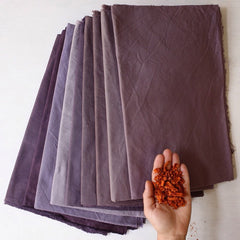 "I'm excited about the color purple! The violet's and all the colors I'm getting from logwood. Dying fabrics is very fun and I want to see the color purple more in my next quilt. Which is really surprising, a year ago I was with Monica (a friend in town who helps me with my hand quilting). She was telling me, 'I just have this feeling that purple would be a beautiful color to use in quilts'. And I'm like, 'hmmm, I don't know... that's not me'. To find myself here today having a stack of purple fabric on my table and I can't wait to make more purple. I think that's what's so much fun about being an artist that continues to grow. Trying new things, new colors and not getting to stuck in one setting."
"I'm excited about the color purple! The violet's and all the colors I'm getting from logwood. Dying fabrics is very fun and I want to see the color purple more in my next quilt. Which is really surprising, a year ago I was with Monica (a friend in town who helps me with my hand quilting). She was telling me, 'I just have this feeling that purple would be a beautiful color to use in quilts'. And I'm like, 'hmmm, I don't know... that's not me'. To find myself here today having a stack of purple fabric on my table and I can't wait to make more purple. I think that's what's so much fun about being an artist that continues to grow. Trying new things, new colors and not getting to stuck in one setting."
"One project I keep talking about and just need to do, is an outstanding project for John Mayer. I don't know how he found the website, but he ordered a couple quilts. We had a short conversation and he wants me to do a guitar case insert. A ceremonial blanket you put on the guitar before you shut the case. So that's out and I want to do it, in fact it's all I want to do. I want to use silk and velvet because they seem really rock and roll. However silk is really hard to piece together. I'm nervous excited, it's been awhile since I've quilted silk. I'll need a good starch on hand. He's a very talented artist and I'm more than honored to have a piece of my art going into his guitar case. I don't know what's happening in the air, but the idea that men are excited about quilts is crazy. It's normally seen as a woman's craft but there's guys who are stoked about it. Guys love indigo. It's a beautiful color that men and women feel strongly connected too."
I think that's what's inspiring about your version of quilting. You're designs have brought it into a very mutual demographic and wider audience.
"Also, my husband and I are collaborating on a book. We've got the greenhouse and the raised beds going. We had the groundwork to start this book and the baby was three months old. But after one month in, we decided it was really intense and turned down the book deal with the publishers. We want to make this book but with the time the publishers gave us, we started to see the book getting watered down. The concept that we wanted to see was going to take two years. To make it work for us, we will write it ourselves, at our own pace. We're calling them guidebooks and written chapter by chapter. We have two done, one on garden design and one on hand quilting. We're having them available in the App Store. With my husband being a developer, he coded this app. We haven't released it yet, it's coming. Folk Fiber's Guidebooks are the next chapter for us!"